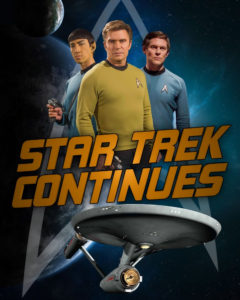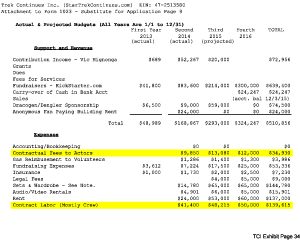 Last time, as 2015 came to a close, STAR TREK CONTINUES was well on its way to a royal fizzbin. They purchased the entirety of the sets in Kingsland, GA, and released their sixth episode, “Divided We Stand.” STC‘s second “Kirkstarter” at the beginning of 2015 had brought in nearly $215,000 to fund their next two episodes and build two new sets: Engineering and a planet set similar to what existed for TOS back in the 1960s on the Paramount lot. And then 2016 brought the release of those next two episodes, “Come Not Between the Dragons“and “Embracing the Winds.”
Last time, as 2015 came to a close, STAR TREK CONTINUES was well on its way to a royal fizzbin. They purchased the entirety of the sets in Kingsland, GA, and released their sixth episode, “Divided We Stand.” STC‘s second “Kirkstarter” at the beginning of 2015 had brought in nearly $215,000 to fund their next two episodes and build two new sets: Engineering and a planet set similar to what existed for TOS back in the 1960s on the Paramount lot. And then 2016 brought the release of those next two episodes, “Come Not Between the Dragons“and “Embracing the Winds.”
With eight episodes completed and released, STC was now way past the mid-point of what was originally intended to be a 13-episode run. Show-runner Vic Mignogna never envisioned STC going past that number of episodes, and joked that he, now well into his fifties, couldn’t play a 35-year-old James T. Kirk forever. Indeed, episodes 7 and 8 already began introducing plot elements that would form into an ongoing story arc that would culminate in the series finale that would end Kirk’s five-year mission and lead into Star Trek: The Motion Picture.
But as 2015 drew to a close, no one suspected that 2016 would turn out to be an uncertain and controversial year, not just for STC, but for all Star Trek fan films. And it all began just before New Years with the filing of a copyright infringement lawsuit by CBS and Paramount against another fan production…Axanar.
STC‘S INDIEGOGO CAMPAIGN
The year-long Axanar lawsuit is covered in excruciating detail elsewhere on this website, and this is a look back on STC. However, by 2016, as you’ll see shortly, STC and Axanar began to affect each other in very public ways. And so one can’t fully cover the history of Star Trek Continues without also mentioning the 800-pound mugato in the cave: Axanar.
Suffice it to say that the lawsuit had a significant and rather devastating effect on Star Trek fan film fandom in general. In addition to creating a near panic among most fan film producers wondering if they would be next, the lawsuit nearly tore apart the fan community as Axanar supporters and detractors took sides and began to battle among themselves on social media.
 By March of 2016, the lawsuit was looking like a game of rugby, with both sides fighting tooth and nail with pre-trial motions…and no settlement or resolution in sight. Into this environment of uncertainty and high emotion, STC launched its third crowd-funding campaign. This time they switched from Kickstarter to Indiegogo for a variety of reasons—including the latter service not requiring a campaign to reach their goal in order to receive the funds raised. The target for the two-month campaign was set at an ambitious $350,000 to cover post-production on episode 7 plus the full production on three more episodes, as well as $5,000/month rent for the next 18 months.
By March of 2016, the lawsuit was looking like a game of rugby, with both sides fighting tooth and nail with pre-trial motions…and no settlement or resolution in sight. Into this environment of uncertainty and high emotion, STC launched its third crowd-funding campaign. This time they switched from Kickstarter to Indiegogo for a variety of reasons—including the latter service not requiring a campaign to reach their goal in order to receive the funds raised. The target for the two-month campaign was set at an ambitious $350,000 to cover post-production on episode 7 plus the full production on three more episodes, as well as $5,000/month rent for the next 18 months.
It should be noted that, at the time the Indiegogo campaign was launched, episodes 6 and 7 had long since been filmed, and episode 6 was nearly ready to debut. In fact, “Come Not Between the Dragons” would premiere just three weeks after the completion of the campaign in early May, and “Embracing the Winds” would be released six months later in September.
With the entirety of STC episodes having been viewed over 4 million times by that point, there was an expectation that the campaign would easily reach $350,000…and a stretch goal of $450,000 was announced at the start that would allow for a fourth episode.
And so it came as a shock to many when, after nearly two months—with just one week left to go—their campaign had managed to raise only $150K from just 1,741 backers. (Their first campaign had 3,000 donors and their second had 2,600.) What had gone wrong???
As far as Vic Mignogna was concerned, the answer was obvious. Having not spoken out publicly up until this point—other than to reaffirm STC‘s commitment to honoring CBS’s ownership of the Star Trek intellectual property and to remind fans and donors that no one on STC was making a salary—Vic’s frustration with Axanar finally boiled over during a podcast interview on April 22. Even though he didn’t name the production or the producer, the following comment really stirred up the already-volatile fan base…on both sides of the issue:
Well, it’s not been going as good as we had hoped, and I’m fairly certain, as are most of our production team that the reason for that is the ‘other production’—that shall not be named—who behaved in such a way that they brought down a lawsuit on themselves. And I think it’s really poisoned the well for the rest of us.
The irony in saying Axanar had “poisoned the well” (which was, in turn, poisoning the well against Axanar) wasn’t lost on many Axanar supporters, including many who were also supporters and donors to STC (like myself). A portion of a video message from Vic to donors during the final week of the campaign only added fuel to the controversy…
Indeed, those same financials Vic mentions in the video thrust STC into the Axanar controversy when fans discovered—thanks to STC’s public Form 1023 filing to the IRS for 501(c)(3) for tax-exempt status—that STC was not “all volunteer” after all. Indeed, over the course of the three years from 2013-2015, STC had paid nearly $165,000 to actors and contract laborers…

Of course, Vic was correct in stating that, unlike Axanar, STC was NOT paying annual salaries to anyone. Those in the cast and on the production crew who were being paid were, on average, charging only 10% of what they normally got paid, and were only being compensated during the two or three weeks a year they were working in Georgia at the studio (not counting post-production like VFX and musical scoring). And of course, Vic himself put tens of thousands of his own dollars into the production.
So yes, there were significant differences between how STC was compensating their people and how Axanar was reportedly doing so. But along with the money Renegades and a couple of other “professional” fan films were paying to their actors and production team, a debate began to happen both among the fans and also within the offices of CBS and Paramount about whether a “fan” film should be made up of ALL unpaid amateurs rather than bringing in paid professional actors and crew (even working at massively discounted rates) to work alongside unpaid volunteers.
WHY DID STC‘S INDIEGOGO COME UP SHORT OF ITS GOAL?
It’s difficult to answer that question with any degree of certainty because there was likely no single reason that resulted in the donations coming in lower than expected. Simply saying that it was all Axanar‘s fault requires someone to ignore a LOT of other factors that were also in play at the time:
Donor fatigue – While 2014 was a veritable “gold rush” for many Trek fan films, 2015 saw a general drop-off months BEFORE the Axanar lawsuit hit. Star Trek: New Voyages had raised $65K from 1,100 donors on Kickstarter in 2014. But in 2015, they only hit $50,000 from less than 800 donors. Renegades almost missed their $375,000 goal in 2015 after easily raising $350,000 the year before. Starship Farragut struggled to just barely make their $15,000 crowdfunding goal, while they had crossed $20,000 a year earlier in 2014. Other fan film campaigns like Star Trek: Anthology, Star Trek: Equinox, and Star Trek: First Frontier failed completely to reach their 2015 Kickstarter goals.
The switch to Indiegogo – At the time, Indiegogo was getting barely one-third of the web traffic than its competitor Kickstater was achieving. Axanar itself saw a drop-off of 10% when they switched from Kickstarter in 2014 to Indiego in 2015. STC‘s donations were following this same pattern, as they finished their Indiegogo campaign about 10% below their previous Kickstarter totals.
 Bad timing – While there’s no “perfect” time to hold a crowd-funding campaign, some times of the year are worse than others. For example, don’t try to compete with the Christmas holidays because people travel and they spend their money on presents more than donating to fan film projects. Likewise, with mainly U.S. backers contributing, Tax Day (April 15) is not necessarily the best time to ask people for money…even if you are a non-profit charity. There’s simply less money available going into April (which was the second month of STC‘s campaign). Also, one wonders what would have happened if STC had held their campaign directly AFTER releasing “Come Not Between the Dragons” instead of having their campaign finish BEFORE the episode premiered.
Bad timing – While there’s no “perfect” time to hold a crowd-funding campaign, some times of the year are worse than others. For example, don’t try to compete with the Christmas holidays because people travel and they spend their money on presents more than donating to fan film projects. Likewise, with mainly U.S. backers contributing, Tax Day (April 15) is not necessarily the best time to ask people for money…even if you are a non-profit charity. There’s simply less money available going into April (which was the second month of STC‘s campaign). Also, one wonders what would have happened if STC had held their campaign directly AFTER releasing “Come Not Between the Dragons” instead of having their campaign finish BEFORE the episode premiered.
This is NOT to say that Axanar had nothing to do with the outcome of STC‘s Indiegogo campaign. It’s likely that a number of fans were worried that the Axanar lawsuit was just the first step in an impending studio shut-down of ALL Trek fan films, and potential supporters feared their donations might be going into a project that would never be completed or allowed to be released. But was that the only factor in play during those two months of the campaign? It’s possible but unlikely.
Regardless of the reasons, STC‘s Indiegogo finished up on May 4, 2016 with $199,049 from 2230 backers. This ranked as the second-highest Indiegogo campaign total for a Trek fan film to date, and the sixth highest total if you included Kickstarter campaigns. So nothing to sneeze at!
But even though nearly $200K was a very impressive total and the team was truly grateful for the fans’ support, there was a perceptible frustration that they had so significantly failed to reach their $350,000 goal.
AND THEN THE GUIDELINES HAPPENED…
As STC was trying to figure out how to apportion the funds from the latest crowd-funding campaign, and wondering whether to do two episodes or try to complete all three that were promoted in the campaign, the world of Star Trek fan films was changed forever with the issuing of new guidelines by CBS and Paramount.
 The guidelines were announced in late June of 2016, and they carried a jolt like a quantum torpedo hit. Concerned about how fan films were taking in hundreds of thousands and sometimes even over a million dollars in donations, CBS and Paramount imposed a $50,000 crowd-funding cap. They also limited the length of fan films to no longer than 15 minutes and not more than two consecutive parts. The words “Star Trek” could no longer appear in the fan films’ title (only the subtitle “A Star Trek Fan Production”). No unlicensed merchandise or services could be distributed as perks via crowd-funding campaigns. And perhaps most controversial of all, fan films were now forbidden from paying anyone associated with the production or employing any actor or professional who had previously worked on any official Star Trek project from episodes and movies to licensed video games, DVD releases, calendars, novels, etc.
The guidelines were announced in late June of 2016, and they carried a jolt like a quantum torpedo hit. Concerned about how fan films were taking in hundreds of thousands and sometimes even over a million dollars in donations, CBS and Paramount imposed a $50,000 crowd-funding cap. They also limited the length of fan films to no longer than 15 minutes and not more than two consecutive parts. The words “Star Trek” could no longer appear in the fan films’ title (only the subtitle “A Star Trek Fan Production”). No unlicensed merchandise or services could be distributed as perks via crowd-funding campaigns. And perhaps most controversial of all, fan films were now forbidden from paying anyone associated with the production or employing any actor or professional who had previously worked on any official Star Trek project from episodes and movies to licensed video games, DVD releases, calendars, novels, etc.
Fans and supporters feared that these new guidelines spelled almost certain doom for Star Trek Continues! After all, STC episodes typically violated many of the guidelines:
- Full-length 50-plus minute episodes
- Crowd-funding way over $50,000
- An ongoing fan series with more than just two parts
- The words “Star Trek” in the title
- Unlicensed perks, some with the words “Star Trek” on them
- Paid professionals (both actors—who were required by Screen Actors Guild rules to be paid for their participation—as well as various other contract labor)
- Use of individuals who had previously or were currently working on actual Star Trek episodes produced by the studios…including Star Trek veterans like actor Michael Forest (who reprised his role of Apollo in STC‘s first episode) and VFX artist Doug Drexler. Heck, even Vic Mignogna himself had done voice-over work for the Star Trek Online game!
STC had just crowd-funded $200,000…but they needed even more to complete the final 6 episodes of their intended 13-episode run. And of course, their average episode length was more than 50-minutes. It would be all-but-impossible to tell a proper STC story in just 15 minutes! And by eliminating the concept of an “ongoing” series, STC couldn’t finish all 6 of their remaining episodes anyway.
How could Star Trek Continues possibly…continue?
RISK…RISK IS OUR BUSINESS!
At first, fans weren’t certain what to make of these new rules. The guidelines began by stating that “CBS and Paramount Pictures will not object to, or take legal action against, Star Trek fan productions that are non-professional and amateur and meet the following guidelines.” So that seemed to mean that any fan film that followed these guidelines did not have to fear a lawsuit or a cease and desist letter or any trouble from the studios.
But what about the reverse? If a fan production violated the guidelines, did that mean that they WOULD be sued? The STC team didn’t see it that way.
By August of 2016, STC had made a bold decision. They would use the money they had cr0wd-funded to produce a final FOUR episodes (not six)…at an accelerated pace. This would save on studio rent costs to the tune of about $40-$50,000, and the rest would come from a combination of careful and frugal production choices.
And what about the guidelines?
Here’s where STC decided to take a risk. They would produce their final four episodes the way they had their previous seven. In short, STC would be ignoring the guidelines and boldly going where their fan production had gone before.
Were they nuts???
Actually, this was a very carefully considered decision. In their view, the team saw the guidelines as NOT saying that, if a production failed to follow the guidelines that they would be sued. If a fan production decided, as STC was deciding, to release something that did not follow the guidelines, CBS and Paramount could choose to take action—or NOT take action—at their discretion.
Over the years, STC had maintained a courteous, respectful, and proactive relationship with the folks at CBS Licensing. Although unconfirmed, it is generally accepted that STC‘s producers reached out to their CBS contacts and promised to wrap up just as soon they they fulfilled their commitment to the fans. STC would produce and release just four more episodes, as quickly as possible, maintain a positive and supportive attitude toward Star Trek, CBS, and Paramount (as they had been doing all along), and then shut down completely.
It was quite a gamble. But would it work?
Next time: the history of Star Trek Continues concludes with a closer look at their final episodes, reaction from CBS and Paramount, and some exclusive video footage from the discussion panel at L.A. Comic Con where Vic and the STC team premiered their eleventh and final episode. And among the questions asked by the audience: what happens to those amazing TOS sets now that the fan series is finished?
All of the amazing offerings of STC can be found on their website at this page:

“…maintain a positive and supportive attitude toward Star Trek, CBS, and Paramount…”
That would explain the U.S.S. Discovery model in the last episode.
Yeppers. 🙂
Hi Jonathon. Another slip? “…what happens to those amazing TOS now that…” doesn’t quite make sense. I think you mean “STC episodes” (??), not sure. But, again, thank you for this story – compulsory reading.
Second thoughts. Or do you mean, ” …. these amazing continuations, and essentially completions, of TOS…”?
Nah, I’m okay with the first fix.
Man! Nobody ever used to report typos! I must be getting old. Hey, get offa my lawn, you kids!!!
If you’d keep that Darned Cat Quiet we probably would!!!
A compliment – “kids”? – I’m in my 70s!!!!
I’m not far behind ya, grandpa. 😉
Having corrected your typo to reveal what you intended to say, I admit to also wondering about the future of those sets. But I also wonder about what the future holds for Vic and the amazing team he assembled for this remarkable series.
Vic claims he is getting too old for playing the role of Kirk. I disagree, he could still carry it off. But, consistent with his viewpont on the series, to change his mind and go back to make more episodes would be a bad move, and one he certainly would not entertain making.
But!
Having achieved his aim, probably at an even higher standard than he may have hoped when he started, a person like Mignogna (and for that matter, a team like the one he assembled) is not going to be content to sit back, content with what has been done. He may think he is too old to play Kirk, but he is too young to stop and will find it impossible to let things now rest. He is too young to sit back and retire, and in particular, retire from his great love of Star Trek.
When anyone with drive and talent achieves anything, it is a natural drive to then feel an imperative to move on to the next project rather than to rest on one’s laurels. So, what next from Vic and his team? That is the question.
You might want to visit this crowd-funding page, Bryan:
https://www.indiegogo.com/projects/when-the-train-stops-movie-film#/
Thanks for this Jonathon. I’m on a limited income but have made a modest contribution to this – it looks to be fun; and what a team!
https://www.youtube.com/watch?time_continue=47&v=aHtJW0NxEjI
Like all studios – when a series production has come to an end – the sets should be either recycled or destroyed.
Or auctioned. CBS made out like a bandit there specifically because Paramount didn’t recycle or destroy everything. That said, I visited the DS9 Promenade set the day before they struck it. I cried a little as I walked around. That set was so amazing.
I don’t get it.
Thank you for the work you put into the things you write. Your articles are very interesting to read. As to STC, do you know, or has there been any info about their future plans. With the amazingly complete and detailed sets that are as good as those for New Yoyages housed in Ticonderoga, NY, have any plans been announced about what will be done with STC’s sets. I am thinking that it would be great if STC could open them up for set tours in the same way as Mr. Cawley has done with their sets. It would really be a good thing to have set tours available to fans who live in the southeast. Ticonderoga is a great place to see, but it would be better to have something a lot nearer. Since the network has already licensed the other, surely there would be no problem in also licensing these sets also. I am thinking that such an attraction would be a great thing for Kingsland, Ga as well. It would provide a good reason for tourists to stop by. Perhaps others have thought of this also? Your thoughts on this would be appreciated.
Tune in this Friday for Vic’s answer to your question.
As to your suggestion, having worked with Trek Licensing myself for about 7-8 years, I can tell you that they endeavor to have only one of each licensing type–one prop maker (or one high-end and one low-end), one online role-playing company, one game app developer, one hobby model company, one book publisher, one holiday ornament seller, etc. This keeps their licensees from being in direct competition with each other and prevents CBS from being put into a position of being accused of “playing favorites.” So no, once James Cawley licensed his set tour, he effectively locked out STC from getting a license for a set tour. That said, maybe they can look to do a different kind of license for something else. I’m just not sure what.
I think it’s become abundantly clear, as to why the studio’s sued Axanar, now, in light of Disco portraying the war with the Klingon ‘s. I know I can’t say they stole the idea, but it’s not coincidence either. I think they saw an opportunity because of fan excitement about the Axanar story.
So, even though I’m a fan of both, it’s hard to pin all blame on Axanar. And, looks like now, in hindsight, that the studio’s showed some favoritism to STC, and Vic.
It’s pretty clear now that CBS was concerned about the casual viewer being confused and thinking that Axanar was the new TV series. Since CBS wanted people to pay to see Discovery, it was actually a realistic financial worry that Axanar could cost CBS subscribers…not because Axanar was better but simply because some folks might think they were watching the new series for free on YouTube.
Which is consistent with my perhaps one dimensional premise that, no matter how high the quality, fan-films following the TOS style and era give no conflict to the current or intended future directions for CBS or for Paramount.
Yeah, but I think CBS and Paramount mostly ignore fan films anyway, sorry to say…or maybe that’s for the best.
Fatigue is why I cut back donations. I made smaller donations to more productions. I hope the sets find a good home. Vic comes across as an OK dude, I met him at the last FarragutFest. I like to think we’re all in this for a common cause. Why can’t the fan productions remember the IDIC?
Most of them do, Scott. Don’t mistake this isolated incident as a trend.